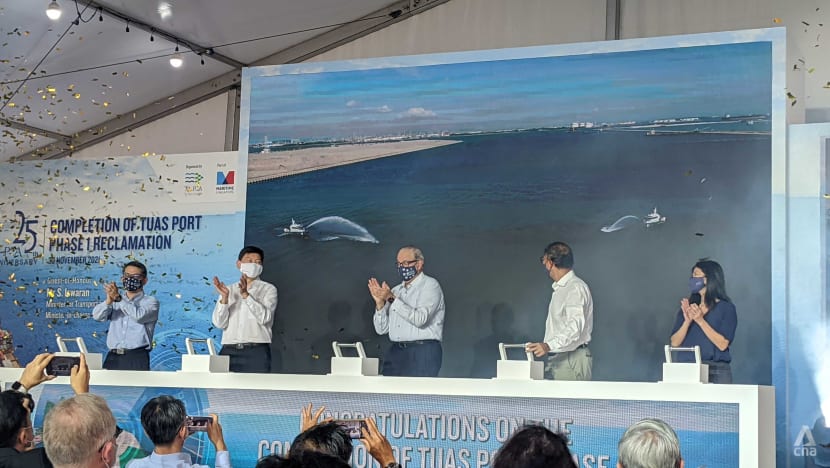Reclamation works for first phase of Tuas Port completed, two berths to open by end-2021

Artist impression of Tuas Port. (Image: Maritime and Port Authority of Singapore)
SINGAPORE: The first two berths at the upcoming Tuas Port are set to be operational by the end of this year, with the completion of reclamation works for the first phase of the mega port project, the Maritime and Port Authority of Singapore (MPA) announced on Tuesday (Nov 30).
This comes about six years after construction works for Tuas port began, which entailed soil improvement works for 414 ha of land, including 294 ha - the equivalent of 412 football fields - of newly reclaimed land.
Construction of the first phase also included the fabrication and installation of 221 10-storey tall caissons - 15,000-tonne concrete structures used to create wharves - to form 8.6km of seawall.
In a media release, MPA said the Tuas Port, which will be completed in the 2040s over four phases, is expected to be capable of handling 65 million TEUs (20-foot equivalent units) annually – double the 36 million TEUs per year Singapore’s port currently handles.
It added that the Tuas Port, which will occupy about 1,337 ha of land when completed, will be an “automated, intelligent and sustainable” port, with electrified automated yard cranes and driverless automated guided vehicles to transport containers between the yard and wharf.
“The completion of Phase 1 reclamation for Tuas Port is a significant milestone, demonstrating our resilience amid adversity, and affirming Singapore’s status as a reliable global hub port trusted by partners,” said Minister for Transport S Iswaran.
Speaking at an event marking the completion of reclamation works for the first phase, Mr Iswaran noted the use of “innovative and sustainable construction methods” has enabled MPA to achieve cost savings of more than S$1 billion for Phase 1.
At the same event, MPA chairman Niam Chiang Meng said reclamation works for Phase 2 of the mega port were also underway, noting this would involve the construction of 9.1km of caissons.
The authorities are also "moving ahead" with plans for Phase 3, he said at the event, which also commemorated MPA’s 25th anniversary.
Mr Niam added that the agency is partnering with others to build an ecosystem around the Tuas Port and prepare for future disruptions, such as the advent of maritime autonomous surface ships.
“In that regard, we have actually started developing autonomous technologies with our technological partners. In fact, they have just had three trials successfully completed and we are looking forward to more developments in that area,” he said.
He added that MPA has also established a network to align standards for such autonomous ships to seamlessly operate across different ports.

Tuas Port will also be greener, he said, noting clay from the sea bed was being used for land reclamation. Together with the National Environment Agency, they will explore the use of mixed materials from the Semakau landfill to reclaim part of the land for Tuas Port, he added.
Mr Niam said that MPA was also looking into the use of greener concrete with reduced carbon.
The agency is also investing heavily in port safety, such as with the development of a next-generation vessel traffic management system that would enhance maritime safety, security and efficiency, he said.
Mr Iswaran, who is also Minister-in-charge of Trade Relations, said that Tuas Port would also be fully automated to enhance the efficiency of port operations.
“Automated cranes and driverless vehicles will more than double labour productivity at Tuas, compared to our city terminals. They will also enable Singaporeans in the port sector to take on skilled jobs with better pay,” he said.
Meanwhile, the MPA’s digitalPORT@SG - a one-stop portal for port transactions - would further enhance the port’s digital infrastructure, he said, adding that the portal already saves the industry 100,000 man-hours annually.
"We will be conducting trials to enable the provision of Just-In-Time services, such as bunkering and repairs. This will further improve the turnaround time of ships," said Mr Iswaran.
Reducing ship idling time would also help reduce greenhouse gas emissions from ships, he added.
Port operator PSA is aiming for the mega port to achieve net zero emissions by 2050, Mr Iswaran said, adding that this would be achieved by using electrified equipment and vehicles, smart power management platforms, and green buildings.
“For example, Tuas Port’s first super low-energy building at Tuas Maintenance Base generates enough solar energy to offset the electricity consumption of the nearby workshops and administration building,” he said, adding this made the base a net zero development.
The minister added that the consolidation of container operations at Tuas by the 2040s would also eliminate inter-terminal haulage and other associated emissions.
The COVID-19 pandemic and global supply chain disruption have "brought out the resilience of Maritime Singapore", Mr Iswaran said.
Despite disruptions and delays, shipping lines have relied even more heavily on Singapore, with the country serving as a “catch-up port” that helped them make up for lost time, he added.
“To cope with the demand, PSA worked closely with MPA and the unions to increase its manning by 20 per cent, and reopen eight berths at Keppel Terminal. PSA has also started to use yard space at Tuas Port to store containers,” he said.
“Our container throughput volumes from January to October this year were 2.1 per cent above the same period in 2020, and 1.3 per cent above the same period in 2019, before COVID-19," he added.
“This means that, barring any surprises, we are on track for a record high in container throughput this year. This strong performance is testament to the trust that maritime companies place in our port.”















